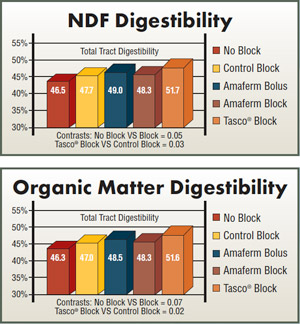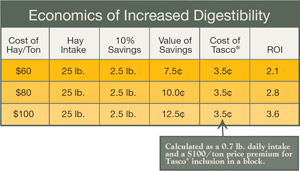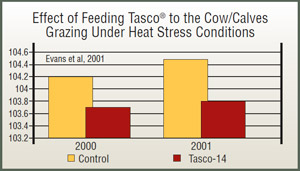
Beef producers are always looking for ways to improve efficiency among their cow herd. Increased intake and improved digestibility are key, and CRYSTALYX® has found a way to do both. Research shows that CRYSTALYX® Tasco® 35-CP can improve fiber and organic matter digestibility when consuming low-quality pasture or harvested forages.

10% Increase in Forage Digestibility
Prior research has shown that supplementing with CRYSTALYX® can achieve a 10% increase in low-quality forage intake. The newest research shows that when supplementing with Tasco® 35-CP, you can increase digestibility of low-quality forages. This North Dakota State University research showed an improvement of 10% in fiber and organic matter digestibility when Tasco® is combined with a CRYSTALYX® 35% protein supplement. The study compared CRYSTALYX® Tasco® 35-CP with a control block, no block and Amaferm in block and bolus form.
Tasco® 35-CP from CRYSTALYX® combines the power of protein (increased intake) and Tasco® (increased digestibility). The result is even better utilization of low-quality forages. Tasco® 35-CP helps improve the substantial benefits of CRYSTALYX® protein delivery by extracting more energy and nutrients from the forage in addition to increasing forage intake.
The economic advantages of a 10% increase in digestibility can be significant, as the chart demonstrates.

The Fescue Advantage
Beyond improved forage utilization, Tasco® has also demonstrated improved temperature regulation for cattle consuming endophyte-infected fescue forage. A study at Mississippi State University showed that cow/calf pairs had lower body temperatures and lower respiration rates when Tasco® was included in the supplement mix.
---------------------------------------------------------------------------------------------------------------------------------
Feeding Strategies in Dry Conditions
The continuing drought in parts of the country makes it necessary for producers to adjust their feeding strategies. A combination of effective supplementation and forage consumption management can make a significant economic difference. Try these suggestions:
Supplement effectively. The key to holding the line on costs during drought supplementation is enabling your cattle to extract all the usable energy from the grazing that is still available.
- A protein supplement like CRYSTALYX® low-moisture blocks will improve the digestibility of low-quality forage. It will also increase the amount of critical energy cows can extract from the forage. A blend of ruminally degradable protein and bypass protein will maximize rumen microbial fermentation efficiencies for digesting low-quality forages. This blend will also improve the protein status of the cow.
- Conserving protein tissues is important because they are metabolically active tissues and organs in your reproductive cows. Cows in a stage of negative energy balance will have great difficulty producing healthy calves, milking sufficiently, and rebreeding on time.
- Provide the same levels of trace minerals as you would during a normal season. It is especially important to encourage sufficient phosphorous consumption.
- Supplement vitamin A, which can be deficient in forages harvested during and after drought.
- Position low-moisture blocks in strategic locations. The blocks will help draw cattle away from traditional loafing areas and into areas that may be underutilized. Research shows CRYSTALYX® can be an even more powerful draw than water.
Control supplement consumption physically, rather than with salt. Salt only increases requirements for clean, fresh water, and that is usually compromised and restricted during periods of drought. Physical consumption control through low-moisture blocks allows you to continue to take advantage of free-choice supplementation without further increasing the cost of labor and fence-walking in anticipation of scheduled deliveries.
Limit grazing if you’re already feeding forages. Pulling animals off drought-stressed range allows grass to rebound when moisture returns.
Cull conservatively. Pregnancy check early and ship non-producers first. Unless you’re scaling back the operation, heavy culling into quality breeding animals should be the last resort. Performance testing pays off when trying to make the right culling decisions.
Wean early, especially your fall calving cows. This presents a management challenge: Early weaned, lightweight calves will be even more vulnerable to the normal stresses of weaning, drylot acclimation, environmental changes and processing.


